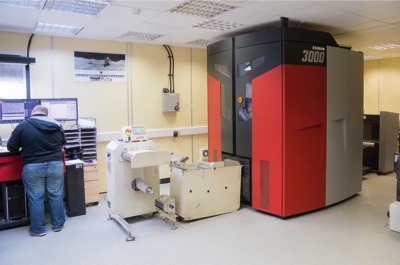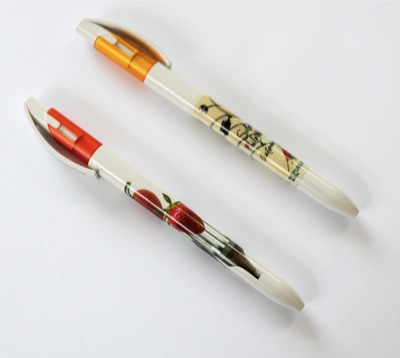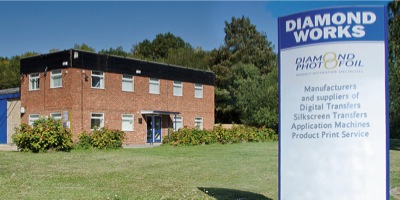A Kent company that pioneered digital thermal transfers is now offering automated applicators. By Simon Eccles.
Heat transfers may not be one of the more obvious uses for digital printing, but for more than ten years the innovative UK company Diamond Photofoil has been successfully building up a market for these in plastic decoration, using a Xeikon 3000 digital press.
Today it offers its services worldwide, supplying a choice of finished printed items, or pre-printed transfers for other companies to apply, or blank foil rolls for other Xeikon users to print on themselves.
It has its own engineering shop and developed a thermal application head and machinery to apply the transfers semi-automatically. Now it has worked in cooperation with the Italian company GPE A. Ardenghi to develop a specialist fully automated applicator for custom pen decoration, and plans larger machines soon.
The company was originally set up in 1968 as an injection moulding company and this still forms an important part of its business. For the past 30 years it has occupied its current site just outside the village of Nettlestead in Kent, about 6 km from Maidstone.
‘About 20 years ago we developed our own silk screen transfer process for our mouldings,’ said David Hitch, managing director. ‘About 12 to 13 years ago we started looking into digital and developed our own transfer foil. Our first Xeikon-built press was installed in 2000 – it was the Agfa Chromapress L320 version. We used it for ten years, although it was upgraded over the years by Xeikon.’
By 2010 the company was ready for a new press and chose the Xeikon 3000, a dedicated single-sided machine optimised for label printing onto roll fed foil papers and plastics. This new, faster press also introduced higher resolution (1200 x 1200 dpi) and new wide gamut QA toners, for transfers up to one metre long and 300 mm wide.
 The pressroom, dominated by the Xeikon 3000. It is largely unmodified apart from adjustments to the fuser temperature
The pressroom, dominated by the Xeikon 3000. It is largely unmodified apart from adjustments to the fuser temperature
Diamond Photofoil uses its own research chemist to develop its foil materials. The lacquer and adhesive can be varied for different substrates: for instance, an alcohol resistant lacquer is used with cosmetics bottles.
By adapting lacquered plastic foil material for printing by the Xeikon, the company has been able to bring all the benefits of digital print to transfer decoration: instant availability with no need for plates or screens; short to medium runs with personalisation if needed; high resolution, wide gamut colours and opaque white undercoats from the Xeikon 3000, plus transfer application from foils and machines developed by Diamond itself.
As the transfers are applied dry with instantsetting adhesive, the printed mouldings can be handled, assembled and packed immediately afterwards. This is far simpler and much more flexible than the alternative of in-mould decoration.
The digital system works so well that the majority of transfers are now made on the Xeikon. The screen press is only used for a limited number of jobs that need metallic or single colours. The company also points to the environmental benefits of the digital toners, which do not use the volatile solvents of screen or gravure inks.
Digital benefits
Being able to print small quantities in full colour at high resolution, with a white backing if needed, allows attractive designs to be developed for smaller quantities and with more variations than have been possible with conventional processes. ‘The very thin transfer gives a ‘non-label’ look,’ said Simon Clark, technical director. ‘It appears to have been printed directly onto the surface. A paper or plastic label is always separate from the item. Brands, especially cosmetics and pharmaceutical companies, are increasingly worried about counterfeiting. They like the ‘printed-on’ transfers because they cannot be removed or replaced.’
How it works
Heat transfers are built up on a roll of plastic film that is discarded once the image is transferred to the final item. The film is coated on one side with a release layer that is heat activated. Over that there is a very thin lacquer layer that forms the final top protective surface of the image. Blank foil rolls are loaded into the Xeikon press, which prints onto the lacquer layer. Its heat process fuses the toner particles together and they adhere to the lacquer. After printing the foils are re-wound and taken to a coating station, where heat-activated adhesive is applied. ‘We use different adhesives depending on what the transfers will be used with,’ said Mr Hitch. Originally the foils were only used with rigid plastics, but there is now an option for flexible plastics (such as polypropylene and polyethylene).
Range of services
Diamond Photofoil offers a range of services: it can print the transfers and apply them to plastic items it has injection-moulded itself; or it can supply printed foils and application machines to customers that want to apply them elsewhere; or it can supply unprinted foil rolls to other Xeikon printers anywhere in the world. The company can help customers with research and development into new materials too. ‘They can send us the transfer product and we will test it on our Xeikon and take it through the whole process, including application,’ explained Mr Hitch. ‘We support Xeikon users worldwide, so we are always sending our material to other users, and testing their jobs here.’ For example, Diamond Printing is a specialist supplier of decorated plastics to the drinks trade.
 An example of the type of jobs the company does for the drinks industry
An example of the type of jobs the company does for the drinks industry
Application machines
Diamond Photofoil has also developed a heated roller head that applies the pre-printed transfers onto a wide range of objects. It calls this a print head, although this actually means it applies the pre-printed images from the foil onto the final objects. The head is made in the company’s engineering section and incorporated in manually loaded application machines that it also builds itself. These can handle large flat or cylindrical objects, such as ice buckets and lids, drinks tap covers, phone covers and iPad covers.
Pen printing
The company also built a specialised applicationmachine for pens and small cylinders such as cosmetic lip gloss and mascara bottles, with a rotary semi-automatic feed. The final image can be completely seamless and looks like direct printing, but with much higher full colour quality than the screen process. ‘We found that there was a need for automation, and almost everyone we were selling to already had GPE A. Ardenghi machines for screen and pad printing,’ said Mr Hitch.
‘It’s a very well known company with decades of experience in this field.’ GPE had an existing machine for screen printing onto pens and small cylinders, called GPE-24. ‘We approached them about integrating our heads into their automatic lines,’ Mr Hitch continued. ‘We got a transfer printer with tried and tested automation from a well known company.’
There are now two models, called GPE/24- TT (for Thermal Transfer), with either fully automatic or semi-automatic feeding. The thermal print application heads are made by Diamond Photofoil, then sent to GPE in Italy to be assembled onto the feed systems.
A fully automatic machine costs around £80,000. The fully automatic machine can handle up to 1200 items per hour, up to 150 mm long and between 8-25 mm diameter. Personalisation is possible too, by printing a bar code on the blank foil area between the pens.

This can be read on the machine and used to co-ordinate an automatic filling and labelling system. Although plastic pens seem to be low value items, Mr Clark said that there is considerable profit potential. ‘A blank plastic pen costs 2p. It costs 10p to print it, but it can be sold for 60p.
We can print 1200 per hour. If you’re selling thousands per day, it’s a profitable business.’ The GPE/24-TT has been sold to users in mainland Europe and the UK as well as North America. One that is happy to go public is Erga in Italy, which offers custom printed designs for its e- Pen DigItaly range that can be ordered online.
Another very large but anonymous user in North America has several Xeikon presses of its own together with multiple GPE/24-TT applicators, printing on Diamond Photofoil blank foils to offer personalised and short run pens with online ordering.
Other transfer processes
Promotional heat transfers are just one of several ‘indirect print’ processes that can be handled by Xeikon presses. The others are textile transfers, water slide decals and industrial transfers.
For textile transfers, a process developed by DST in Denmark combines colour images printed on a Xeikon, then a white undercoat and DST’s own glue applied by screen press. The images are transferred to textiles using widely available heat presses.
Water slide decals are used for difficult shapes such as sports helmets and ceramic plates and bowls. They are usually applied by hand. Here a paper carrier is coated with water-soluble gum, then the toner image is printed onto that. A protective lacquer is applied on top.
Heat transfers are used for ‘promotional’ purposes, such as Diamond Photofoil’s high quality images. However, a very similar process is also used for ‘industrial’ work, such as labels for paint and chemical drums that have to be tear-proof and chemical resistant.
It’s evident that heat transfers have considerable future potential even beyond today’s use on plastics. Diamond Photofoil is now working on foils suitable for metals, glass, ceramics and other materials, and it is also co-operating with GPE in automating more of its application systems. The coming year should prove interesting





